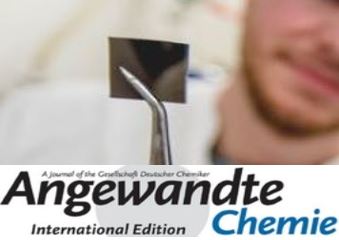Ultra-thin transparent silver films may boost solar cell efficiency as well as light-emitting diodes (LEDs). Scientists at Ruhr-Universität Bochum and the University of Wuppertal in Germany have developed a fabrication process for transparent ultra-thin silver films.
The material may help create highly efficient light-emitting diodes and solar cells. Light-emitting diodes or LEDs are semiconductor diodes which glow when a voltage is applied.
Solar cells capture solar energy and create electricity in, for example, solar panels.
The researchers have written about their work in the journal Angewandte Chemie International Edition (citation below). ‘Angewandte Chemie’ is German for ‘Applied Chemistry.’
Professor Anjana Devi and Nils Boysen headed a team that collaborated with Professor Thomas Riedl’s group. Prof. Devi and Boysen are from the Bochum-based research group Inorganic Materials Chemistry. Prof. Riedl is the Chair of Electronic Devices in Wuppertal.
Fabricating silver films – precursors
Boysen, a Master student, explained:
“Precursors for the fabrication of ultra-thin silver films are highly sensitive to air and light.
It is possible to stabilize the silver precursors with oxygen, phosphorous, or fluorine.

Boysen added:
“However, these elements contaminate the thin films as well as the equipment used for the production.”
While writing his thesis, Boysen and colleagues developed an alternative solution regarding common silver precursor problems.
The scientists created a chemical silver precursor. In this precursor, a carbene and an amide surrounded the silver, which was stable, even without elements such as oxygen, phosphorous, or fluorine.
The researchers demonstrated that they could apply a silver thin film to an electrode with the new precursor using layer deposition.
During the process, the gaseous precursor was transported to the electrode while a silver film was deposited on it as an ultra-thin layer. So thin, in fact, that the transparent layer was only a few atoms thick.
Prof. Devi said:
“As the process can be operated under atmospheric pressure and at low temperatures, the conditions for industrial production are quite favorable.”
A step towards highly efficient solar cells and lights
The researchers carried out a series of tests. Their tests showed that the thin silver films were pure and electrically conductive when they manufactured them using this method.
Prof. Riedl said:
“As far as process technology is concerned, the successful synthesis of the new precursor paves the way for the development of ultra-thin silver films.”
“It constitutes a first step towards the production of novel electrodes for highly efficient solar cells and lights.”

Prof. Devi stressed:
“The collaboration between the chemists from Bochum and the engineers from Wuppertal was the key to success.”
Citation
“An N‐Heterocyclic Carbene Based Silver Precursor for Plasma‐Enhanced Spatial Atomic Layer Deposition of Silver Thin Films at Atmospheric Pressure,” Nils Boysen, Tim Hasselmann, Dr. Sarah Karle, Dr. Detlef Rogalla, Dr.‐Ing. Detlef Theirich, Manuela Winter, Prof. Dr. Thomas Riedl, and Prof. Dr. Anjana Devi. Angewandte Chemie International Edition (2018). DOI: https://doi.org/10.1002/anie.201808586.

